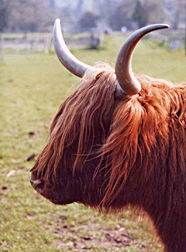|
Read the
magazine
story to find out more. |
|

Feral cattle that have lived for more than 100
years on Chirikof Island, which lies about 60 miles southwest of Alaska's
Kodiak Island, are genetically distinct from commercial breeds raised in the
U.S., although they are close cousins of highland cattle in the United Kingdom.
Photo courtesy of Baylham House Rare Breeds Farm.
|
|

|
Feral Cattle Isolated and Genetically
Distinct
By Laura
McGinnis September 9, 2008
Feral cattle on Alaska's Chirikof Island are genetically distinct from
commercial breeds raised in the United States. That's the conclusion of
Agricultural Research Service (ARS)
scientists studying the genetic diversity of these hardy animals.
Treeless, desolate and cold, Chirikof Island lies about 60 miles
southwest of Alaska's Kodiak Island. For more than 100 years, the island has
been home to a herd of feral cattle whose origin is unknown.
To assess the genetic diversity of the island's herd,
Michael
D. MacNeil, a geneticist at the ARS
Fort
Keogh Livestock and Range Research Laboratory in Miles City, Mont., worked
with Matt Cronin of the University of
Alaska-Fairbanks (UAF). They collected blood and tissue samples from 21
cattle and compared DNA from these samples with that of several North American
commercial breeds, obtained from breeders and the ARS
National Animal
Germplasm Program (NAGP) in Fort Collins, Colo.
The scientists then collaborated with colleagues at
Colorado State University to analyze
the samples. They determined that Chirikof cattle had a relatively small degree
of genetic relatedness with other breeds.
A related study showed that the Chirikof cattle genes were
comparatively similar to those of Siberian Yakut cattle. Yakut are small,
stocky and extremely hardy, but their genetic material is increasingly limited.
The researchers concluded that the hardy Chirikof cattle and their genetic
samples are unique and may have benefits for the cattle industry.
Although the ARS studies did not include analysis of the effects of
the cattle's unique genes, they may relate to characteristics--such as cold
hardiness or adaptability to specific forages--that would be valuable to cattle
breeders and producers.
Read more
about the research in the September 2008 issue of Agricultural Research
magazine.
ARS is a scientific research agency of the
U.S. Department of
Agriculture.